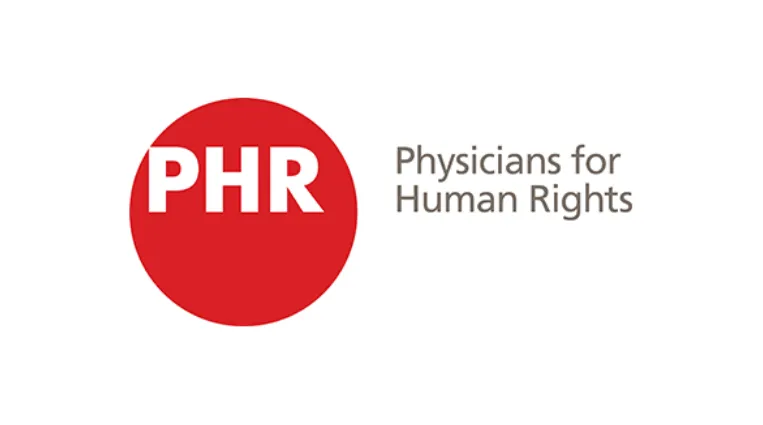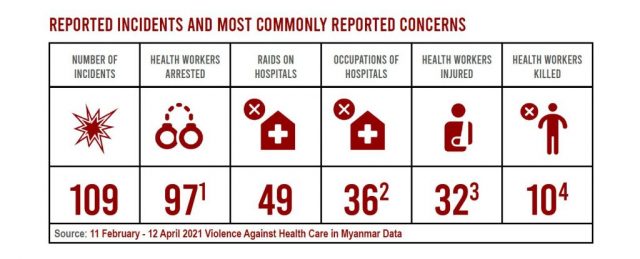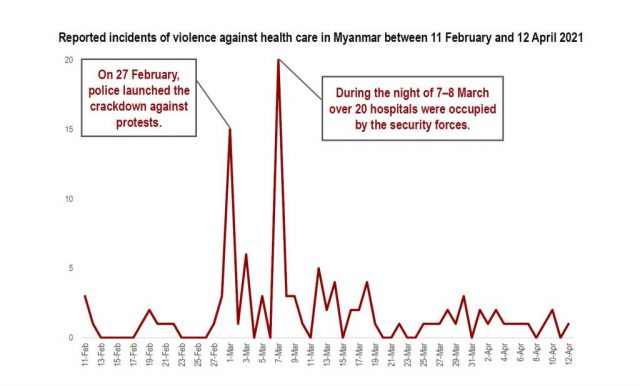Violence Against Health Care in Myanmar
20 April 2021

This research brief was prepared from information complied by Insecurity Insight, Physicians for Human Rights, and the Center for Public Health and Human Rights, Johns Hopkins Bloomberg School of Public Health based on open source data.
Around 1 p.m. on 28 March 2021 Myanmar security forces began shooting at protesters in Sanchaung township, Yangon city. As protesters fled the attack and some sought refuge in the Asia Royal Hospital, soldiers and police chased them inside, opening fire with rubber bullets and injuring at least one male hospital staff member who was exiting the hospital.
The security forces occupied the ground floor of the hospital and surrounded the building for approximately thirty minutes following the incident. The shooting took place near the hospital’s outpatient treatment centre for patients suffering from heart-related health issues.
Mass Civil Disobedience Movement (CDM) protests have been taking place across Myanmar after the Myanmar armed forces (known as the Tatmadaw) seized control of the country on 1 February following a general election that the National League for Democracy party won by a landslide.
The military have since declared a state of emergency to last for at least a year, and numerous countries have condemned the takeover and subsequent violent crackdown on protesters. Hundreds of people, including children, have been killed and many injured during the protests. The violence has impacted health workers, hospitals and ambulances.
On 9 April 2021 the military junta announced during a televised press conference that all health workers participating in CDM protests would be considered to be committing genocide.
This document is the result of collaboration between Insecurity Insight, Physicians for Human Rights (PHR), and the Center for Public Health and Human Rights, Johns Hopkins Bloomberg School of Public Health as part of the Safeguarding Health in Conflict Coalition (SHCC). It highlights reported incidents of violence against health workers, facilities and transport in Myanmar between 11 February and 12 April 2021. It does not include information on violence against patients.
The incidents referred to are based on the dataset 11 February – 12 April 2021 Violence Against Health Care in Myanmar Data, which is available on the Humanitarian Data Exchange (HDX).


- Between 11 February and 12 April 2021, 109 incidents of violence against health care were documented in Myanmar.
- Incidents were frequently reported from Mandalay and Yangon city, where the protests originated. There were also reports of incidents in Ayeyarwady, Chin, Kayah, Mon, Sagaing, Shan and Tanintharyi states, and Naypyitaw Union Territory.
- Tatmadaw soldiers or associated police forces were the reported perpetrators in all incidents.
- Hospitals were raided and occupied and ambulances shot at. Health workers were arrested, injured, and in some cases killed in close-range shootings.
- Emergency medical teams were shot at with live rounds while trying to retrieve or treat injured civilians at protests.
- Health workers were intimidated, arrested and evicted from government housing on suspicion of participating in the CDM.
- Aid offices and organisations’ storerooms containing medical equipment were raided after the organisations had provided medical care to protesters.
- Private clinics and hospitals across the country were issued with official directives mandating that injured civilians could not be seen or treated without first notifying the military.
- Teargas was fired inside hospitals while health workers were trapped inside, staff were beaten and patients’ rooms searched. In some cases CCTV records were erased and medical supplies destroyed.
- On the night of 7 March over 20 hospitals were occupied throughout the country. 567 Myanmar military forces used live rounds, stun grenades and rubber bullets during these forced entries.
Recommendations
Over the past five years members of the international community have made many commitments to carrying out the requirements of UN Security Council Resolution 2286, which strongly condemns attacks on medical personnel in conflict situations and was adopted in May 2016. Many states have formally reiterated their commitments, including in the July 2019 Call for Action to strengthen respect for international humanitarian law and principled humanitarian action, which was signed by more than 40 states.
All UN member states should:
- adhere to the provisions of international humanitarian and human rights law regarding respect for and the protection of health services and the wounded and sick, and regarding the ability of health workers to adhere to their ethical responsibilities of providing impartial care to all in need;
- ensure the full implementation of Security Council Resolution 2286 and adopt measures to enhance the protection of and access to health care in situations of armed conflict, as set out in the Secretary-General’s recommendations to the Security Council in 2016; and
- strengthen national mechanisms for thorough, impartial, and independent investigations into alleged violations of obligations to respect and protect health care in situations of armed conflict and for the prosecution of the alleged perpetrators of such violations.
Data Collection
- The documentation and verification of the kinds of incidents described in this document are important.
- See our global map for reported incidents. Select ‘Myanmar’ by clicking on it on the map and selecting the timeframe ‘11 February to 12 April 2021’ for reported incidents.
- To share further incidents or report additional information or corrections, please contact [email protected].
This document is published by Insecurity Insight. It is prepared from information compiled by Insecurity Insight, Physicians for Human Rights, and the Center for Public Health and Human Rights, Johns Hopkins Bloomberg School of Public Health that is available in local, national, and international news outlets, online databases, and social media reports.
The incidents reported are neither a complete nor a representative list of all incidents. Most incidents have not been independently verified and have not undergone verification by Insecurity Insight, Physicians for Human Rights, or the Center for Public Health and Human Rights, Johns Hopkins Bloomberg School of Public Health.
All decisions made on the basis of or in light of such information remain the responsibility of the organisations making such decisions. Data collection is ongoing and data may change as more information is made available.
The publication of this report is funded and supported by the Foreign, Commonwealth and Development Office (FCDO) of the UK government through the RIAH project of the Humanitarian and Conflict Response Institute at the University of Manchester, and by the generous support of the American people through the United States Agency for International Development (USAID).
The contents are the responsibility of Insecurity Insight and do not necessarily reflect the views of USAID or the US government.
Suggested citation: Insecurity Insight. 2021. ‘Violence Against Health Care in Myanmar 11 February – 12 April 2021.’ Geneva, Switzerland: Insecurity Insight.
1 The WHO Surveillance System of Attacks on Healthcare (SSA) documented 266 health worker arrests or detentions. On 28 February the WHO SSA documented 200 arrests among a protest group (accessed 12 April 2021).
2 The WHO SSA documented 33 incidents of the militarisation of health facilities (accessed 12 April 2021).
3 Nine health worker injuries were documented by the WHO SSA (accessed 12 April 2021).
4 Six health worker deaths were documented by the WHO SSA (accessed 12 April 2021)
5 The UN has reported 26 hospitals being occupied.
6 The WHO SSA documented 28 incidents in which health facilities were occupied on 8 March 2021 (accessed 12 April 2021).
7 Only incidents with location information are included in the dataset.
Announcements
28 February 2025
Asian NGO Network on National Human Rights Institutions , CSO Working Group on Independent National Human Rights Institution (Burma/Myanmar)
Open letter: Removal of the membership of the dis-accredited Myanmar National Human Rights Commission from the Southeast Asia National Human Rights Institution Forum

Progressive Voice is a participatory rights-based policy research and advocacy organization rooted in civil society, that maintains strong networks and relationships with grassroots organizations and community-based organizations throughout Myanmar. It acts as a bridge to the international community and international policymakers by amplifying voices from the ground, and advocating for a rights-based policy narrative.